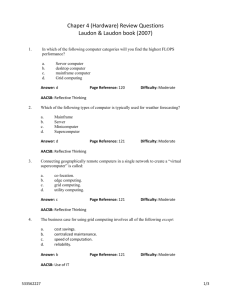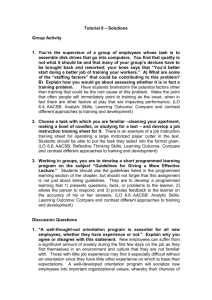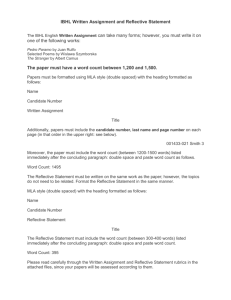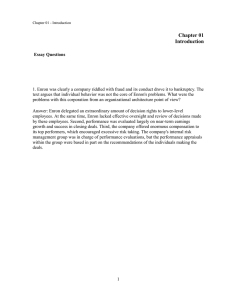BUS-201-202: TUTORIAL 12(CHAPTER 17) CLASS EXERCISE
advertisement
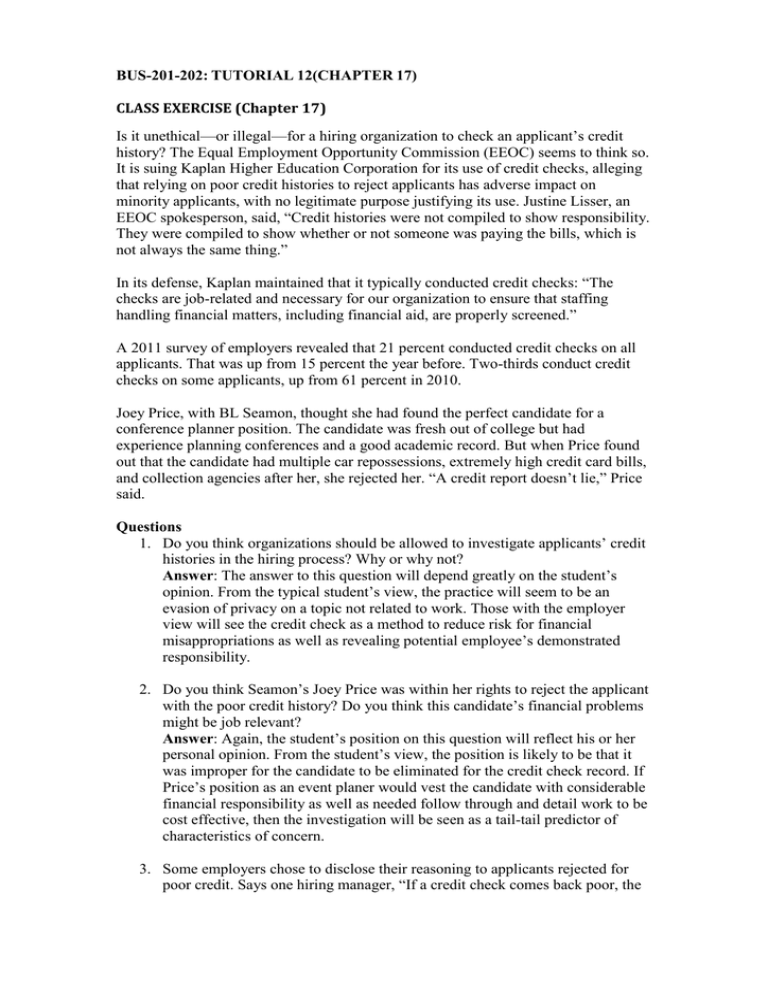
BUS-201-202: TUTORIAL 12(CHAPTER 17) CLASS EXERCISE (Chapter 17) Is it unethical—or illegal—for a hiring organization to check an applicant’s credit history? The Equal Employment Opportunity Commission (EEOC) seems to think so. It is suing Kaplan Higher Education Corporation for its use of credit checks, alleging that relying on poor credit histories to reject applicants has adverse impact on minority applicants, with no legitimate purpose justifying its use. Justine Lisser, an EEOC spokesperson, said, “Credit histories were not compiled to show responsibility. They were compiled to show whether or not someone was paying the bills, which is not always the same thing.” In its defense, Kaplan maintained that it typically conducted credit checks: “The checks are job-related and necessary for our organization to ensure that staffing handling financial matters, including financial aid, are properly screened.” A 2011 survey of employers revealed that 21 percent conducted credit checks on all applicants. That was up from 15 percent the year before. Two-thirds conduct credit checks on some applicants, up from 61 percent in 2010. Joey Price, with BL Seamon, thought she had found the perfect candidate for a conference planner position. The candidate was fresh out of college but had experience planning conferences and a good academic record. But when Price found out that the candidate had multiple car repossessions, extremely high credit card bills, and collection agencies after her, she rejected her. “A credit report doesn’t lie,” Price said. Questions 1. Do you think organizations should be allowed to investigate applicants’ credit histories in the hiring process? Why or why not? Answer: The answer to this question will depend greatly on the student’s opinion. From the typical student’s view, the practice will seem to be an evasion of privacy on a topic not related to work. Those with the employer view will see the credit check as a method to reduce risk for financial misappropriations as well as revealing potential employee’s demonstrated responsibility. 2. Do you think Seamon’s Joey Price was within her rights to reject the applicant with the poor credit history? Do you think this candidate’s financial problems might be job relevant? Answer: Again, the student’s position on this question will reflect his or her personal opinion. From the student’s view, the position is likely to be that it was improper for the candidate to be eliminated for the credit check record. If Price’s position as an event planer would vest the candidate with considerable financial responsibility as well as needed follow through and detail work to be cost effective, then the investigation will be seen as a tail-tail predictor of characteristics of concern. 3. Some employers chose to disclose their reasoning to applicants rejected for poor credit. Says one hiring manager, “If a credit check comes back poor, the potential employee has a week to dispute and correct the errors.” What are the advantages and disadvantages of such a policy? Answer: Again, the student’s answer will depend on his or her opinion. But, he of she is likely to indicate this policy opens fairness to the candidate to respond to the negative findings instead of being blindsided without recourse to refute the decision. Sources: J. Zappe, “Survey Finds More Companies Credit-Checking Candidates,” ERE.net (May 16, 2011), downloaded on July 11, 2011, from www.ere.net/2011/; S. Greenhouse, “Hiring Suit Takes on Bias Based on Credit,” New York Times (December 22, 2010), pp. B1, B4; J. Fairley, “Employers Face Challenges in Screening Candidates,” Workforce Management (November 2010), pp. 7–9; and B. Roberts, “Close-Up on Screening,” HR Magazine (February 2011), p. 23–29. REVIEW QUESTIONS (CHAPTER 17) 1. Define initial selection, and identify the most useful method? Answer: Initial Selection. Initial selection devices are the first information applicants submit and are used for preliminary “rough cuts” to decide whether an applicant meets the basic qualifications for a job. a. Application Forms. Application forms can be a good initial screen. They take very little time and more organizations encourage applicants to submit an application online. b. Background Checks. More than 80 percent of employees check references; however, rarely is useful information gained (This exercise covers Learning Objectives: Define initial selection, and identify the most useful method; Learning Outcomes: Describe the components of human resource practices; and AACSB Learning Goals: Reflective thinking skills). 2. Define substantive selection and identify the most useful methods? Answer: Substantive Selection is the heart of the selection process. This is used after passing initial screening. A variety of metrics can be used that include skill tests, personality tests, and other more sophisticated techniques such as performance simulations. Interviews are the most common selection tool. (This exercise covers Learning Objectives: Define substantive selection, and identify the most useful method; Learning Outcomes: Describe the components of human resource practices; and AACSB Learning Goals: Reflective thinking skills.) 3. Define contingent selection and contrast the arguments for and against drug testing? Answer: Contingent Selection. One final process in the hiring process when the applicant is ready to be hired but contingent on a final check like a drug test. Some people think that drug testing is unfair, invasive or a private matter. Drug tests usually screen out those who have used marijuana but not alcohol that is legal and also leaves the system in 24 hours. The argument for drug testing is that it is generally accurate and can help detect a problem before the person becomes an employee. (This exercise covers Learning Objectives: Define contingent selection, and contrast the arguments for and against drug testing; Learning Outcomes: Describe the components of human resource practices; and AACSB Learning Goals: Reflective thinking skills.) 4. Compare the four main types of training? Answer: a. Basic Literacy Skills - One half of U.S. high school graduates do not have the basic skills necessary for work b. Technical Skills - Focus of most training, especially given the pace of technological change c. Interpersonal Skills - Skills like effective listening, communication, and teamwork d. Problem-solving Skills - Help sharpen logic and reasoning, and provide helpful decision-making techniques (This exercise covers Learning Objectives: Compare the four main types of training; Learning Outcomes: Describe the components of human resource practices; and AACSB Learning Goals: Reflective thinking skills.) 5. Contrast formal and information training methods? Answer: Historically, training meant formal training. It is planned in advance and has a structured format. Organizations are increasingly relying on informal training—unstructured, unplanned, and easily adapted to situations and individuals. Most informal training is nothing other than employees helping each other out. They share information and solve work-related problems with one another. On-the-Job (OJT) includes job rotation, apprenticeships, understudy assignments, and formal mentoring programs. OJT can be disruptive to the workplace. Off-the-Job training may include classroom lectures, videotapes, seminars, self-study courses, Internet-based courses, role-plays, and case studies. (This exercise covers Learning Objectives: Contrast formal and informal training methods; Learning Outcomes: Describe the components of human resource practices; and AACSB Learning Goals: Reflective thinking skills.) 6. Contrast on-the-job and off-the-job training? Answer: On-the-job training includes job rotation, apprenticeships, understudy assignments, and formal mentoring programs. The primary drawback of these methods is that they often disrupt the workplace. Organizations are investing increasingly in off-the-job training—nearly $125 billion annually. The most popular is live classroom lectures. It also encompasses videotapes, public seminars, self-study programs, Internet courses, satellite-beamed television classes, and group activities that use roleplays and case studies. Recently, e-training (computer-based training) is the fastest growing training delivery mechanism. E-learning systems emphasize learner control over the pace and content of instruction, allow e-learners to interact through online communities, and incorporate other techniques such as simulations and group discussions. Computer-based training that let learners actively participate in exercises and quizzes was more effective than traditional classroom instruction. On the positive side, e-training increases flexibility because organizations can deliver materials anywhere, anytime. On the other hand, it’s expensive to design self-paced online materials, employees miss the social interaction of a classroom, online learners are more susceptible to distractions, and “clicking through” training without actually engaging in practice activities provides no assurance employees have actually learned anything. (This exercise covers Learning Objectives: Contrast one-the-job and off-the-job training; Learning Outcomes: Describe the components of human resource practices; and AACSB Learning Goals: Reflective thinking skills.) 7. Describe the purposes of performance evaluation, and list the methods by which it can be done. Answer: Purposes of Performance Evaluation 1. Management uses evaluations for general human resource decisions, such as promotions, transfers, and terminations. 2. Evaluations identify training and development needs. 3. They pinpoint employee skills and competencies needing development. 4. Criterion against which selection and development programs are validated 5. They provide feedback to employees on how the organization views their performance and are often the basis for reward allocations including merit pay increases. 6. We will emphasize performance evaluation in its role as a mechanism for providing feedback and as a determinant of reward allocations. (This exercise covers Learning Objectives: Describe the purposes of performance evaluation, and list the methods by which it can be done; Learning Outcomes: Describe the components of human resource practices; and AACSB Learning Goals: Reflective thinking skills.) 8. Show how managers can improve performance evaluation processes? Answer: Performance evaluation processes can be improved using the following suggestions: a. Use multiple evaluators to overcome rater biases - Halo and leniency errors b. Evaluate selectively based on evaluator competence c. Train evaluators to improve rater accuracy d. Provide employees with due process e. Individuals are provided with adequate notice of performance expectations f. All relevant evidence of a violation is aired in a fair hearing, with the individual given an opportunity to respond g. Final decision is based on the evidence and is free of bias (This exercise covers Learning Objectives: Show how managers can improve performance evaluations; Learning Outcomes: Describe the components of human resource practices; and AACSB Learning Goals: Reflective thinking skills.) 9. Describe how organizations can manage work-family conflicts? Answer: It can be managed through a variety of programs to reduce work/life conflict and increase balance for employees such as: a. Flexible scheduling and benefits b. On-site personal services (like dry cleaning or a gym) c. Time-, information- or money-based strategies available. (This exercise covers Learning Objectives: Describe how organizations can manage workfamily conflicts; Learning Outcomes: Describe the components of human resource practices; and AACSB Learning Goals: Reflective thinking skills.)


